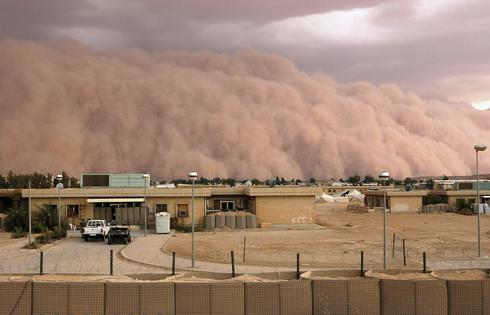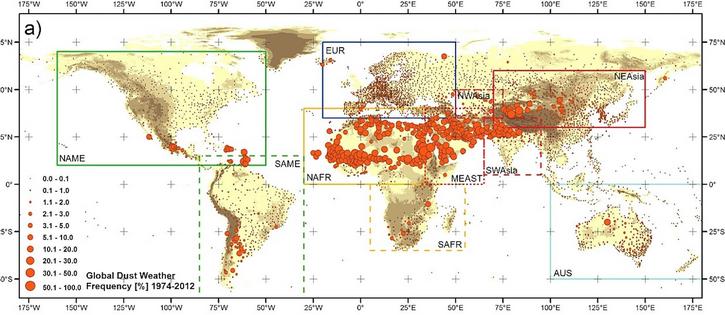Desert dust storms carry human-made toxic pollutants, and the health risk extends indoors
Published in Science & Technology News
Humans have contended with dust storms for thousands of years, ever since early civilizations appeared in the Middle East and North Africa. But modern desert dust storms are different from their preindustrial counterparts.
Around the world, deserts now increasingly border built structures, including urban dwellings, manufacturing, transportation hubs, sewage treatment and landfills. As a result, desert dust lifts a growing load of airborne pollutants and transports these substances over long distances.
This is happening throughout the Global Dust Belt, an arid to semiarid region that stretches from western China through Central Asia, the Middle East and North Africa. Similar storms occur in the U.S. Southwest and central Australia.
To our thinking, modern desert dust storms have been overlooked as a public health crisis. Elevated exposure to these events is likely to contribute to rising respiratory and other diseases, including asthma and chronic obstructive pulmonary disease. We are environmental researchers whose work shows a need for better public health practices to protect people from dust storm pollutants.
To appreciate the scale of the threat, consider the Arabian Peninsula, where asthma rates have been the world’s highest for the past two decades.
In spring 2011, one of the most severe desert dust storms in recent decades swept across the Middle East at the peak of the dust storm season. Its plumes spread from the west coast of the Persian Gulf to the eastern shores of the Caspian Sea, covering northern Saudi Arabia, southern Iraq, Kuwait and western Iran. One quadrant of this large storm alone covered most of the Arabian Peninsula.
This storm reached vertically as high as 5.5 miles (9 kilometers) above the ground. Its wind speeds exceeded 45 mph (72 kilometers per hour) – higher than average wind speeds in the region. Dust particle concentrations peaked at 530,000 micrograms per cubic foot (15,000 micrograms per cubic meter), blocking sunlight for days.
One study found that a large proportion of individuals exposed to sandstorms had symptoms that included increased cough, runny nose, wheezing, acute asthmatic attack, eye irritation and redness, headache, sleep disturbance and psychological disturbances. Another study reported that increased dust storm exposure in western Iran led to increases in hospital admissions for chronic obstructive pulmonary disease and more deaths from respiratory causes.
Researchers study desert dust storms in a dozen different fields, each with its own terminology, expertise and body of knowledge. This work includes analyzing satellite images, creating simulation models for predicting dust particle transport, and identifying each dust storm’s particle content. So far, however, the health effects of desert dust storms and their changing particle content have gotten scant attention.
As we discussed in a recent review article, studies have found pollutants in dust storms that include bioreactive metals such as copper, chromium, nickel, lead and zinc, as well as pesticides, herbicides, radioactive particulates and aerosolized sewage. The extent to which desert dust storms transport a special class of pollution particles, those even smaller than one micron – or one millionth of a meter – is not yet clear.
This is the class of submicron pollutants, abbreviated as PM1.0, which includes degraded microplastics, metallic nanoparticles, diesel exhaust and fine particles from degraded tires. Of all particulate matter classes, submicron particles are the most harmful to human health because when once inhaled, they enter the bloodstream, affecting every organ in the body, and even crossing the blood-brain barrier.
We offer several practices here that we believe would help public health agencies successfully tackle the problem of polluted dust storms.
1: Identify particle content for each dust storm.
Existing technology now makes it possible to identify the types of particles being carried in any particular storm. Scientists can already conduct particle trajectory analysis to trace dust and pollutant particles back to their sources.
Knowing the particle content of dust storms can identify ways to make these storms less hazardous, whether capping sewage systems or securing waste at ports to prevent materials from being picked up by dust storms.
2: Archive samples from each desert dust storm.
One physical catalog for dust storm particles already exists at the 19th-century dust storm archive kept by the Natural History Museum at Humboldt University in Berlin. We see a need for a modern archive that collects digital data on particle types, particle trajectory analysis, spatial coordinates and meteorological data.
Keeping both physical samples and data from each dust storm would allow for a comparative understanding of how and why particle content is changing. This has been done to analyze particle content related to military activity in the Middle East.
3: Protect indoor and closed spaces from the smaller dust storm particles.
During a major dust storm, high-speed winds blow fine particles around windows and doors for days. The particles most likely to penetrate indoors include the smallest, most harmful submicron class.
Typically, a gray, fluffy residue appears inside buildings after a dust storm, but there is no data so far on the identity and size of these particles. Our concern is that submicron pollutant particles are highly concentrated in this residue.
For a safe cleanup, we recommend that people should avoid dry vacuuming, which lofts particles back into the air. Instead, it is better to remove residues with water and a wet mop. We also recommend wearing face masks indoors before, during and after dust storms, since particulate concentrations start to rise ahead of the main storm. In our view, people should treat dust storm residue inside built structures as hazardous material until studies show otherwise.
4: Educate biomedical and meteorological experts together.
The rising human-made content of desert dust storms, particularly fine and ultrafine submicron particles, is a neglected public health concern that we believe calls for combined medical and meteorological expertise.
By educating biomedical and meteorological experts jointly about dust storms, public health agencies would have more complete strategies for how to best protect people. It would be valuable to have teams of health and weather experts carry out joint analyses of dust storm exposure data, and then apply the best statistical methods to both civilian and military health records.
Climate change is making already-dry areas around the world more arid. As deserts increasingly adjoin cities, industry and transportation corridors, desert dust storms will increasingly mirror human activity on land. These storms are becoming flying waste dumps, and we believe a public health perspective will help produce more effective responses.
This article is republished from The Conversation, an independent nonprofit news site dedicated to sharing ideas from academic experts. If you found it interesting, you could subscribe to our weekly newsletter.
Read more:
Increased deaths and illnesses from inhaling airborne dust: An understudied impact of climate change
Fine particle air pollution is a public health emergency hiding in plain sight
Fatin Samara has received funding from the American University of Sharjah and the Sharjah Research Academy.
Claire Williams Bridgwater does not work for, consult, own shares in or receive funding from any company or organization that would benefit from this article, and has disclosed no relevant affiliations beyond their academic appointment.











Comments